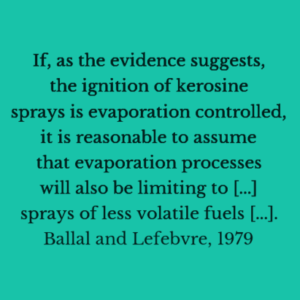1-Sentence-Summary: A mathematical model of heterogeneous fuel combustion is developed and demonstrates the quenching distance/minimum ignition energy of quiescent and flowing mixtures.
Authors: D. Ballal and A. Lefebvre
Read in: Three Minutes
Favourite quote from the paper:

The current authors develop a mathematical model of ignition for heterogeneous fuel mixtures. Strictly liquid fuels (droplets) such as iso-octane, kerosine, and diesel oil are studied. The reason that I am reviewing this here is that I believe that mathematical models such as this will also be useful to study dust explosion phenomena.
The mathematical model assumes that chemical kinetics and gaseous fuel mixing are much faster than the fuel vaporization process. It is assumed that the spark creates a hot spherical volume of gas. Ignition occurs when the heat released from reactions within the volume just exceeds the rate of heat loss to the surroundings. Radiation and internal flow inside the droplets are neglected. Vaporization of the droplet is modeled using a fuel mass transfer number approach and this term would likely need to be modified to investigate solid particulate fuels.
In the paper experimental results are presented and compared to the mathematical model. The effect of initial pressure, flow velocity, turbulence intensity, equivalence ratio, mean droplet size, and fuel volatility are also explored.
Three of the main findings from this paper are:
- Mathematical relations for quenching distance/minimum ignition energy compare well with experimentally determined values
- The minimum ignition energy is proportional to the inverse square root of the initial gas density
- A critical mean droplet diameter is defined, under which evaporation is no longer limiting the ignition process.
The following sections outline the main findings in more detail. The interested reader is encouraged to view the complete article at the link provided below.
Finding #1: Mathematical relations for minimum ignition energy can be derived from the model at different operating conditions
Minimum ignition energy results from the mathematical model are compared to experimental data for varying mean droplet size, equivalence ratio, droplet velocity, initial pressure, and turbulence intensity. The minimum ignition energy decreases with mean particle size in a log-log-linear fashion showing the important role of the surface area dominated evaporation process. The minimum ignition energy decreases with increasing equivalence ratio moving from almost 2 mJ at an equivalence ratio of 0.4 to almost 0.1 mJ at an equivalence ratio of 0.8, for 50 µm iso-octane droplets at 15 m/s velocity.
Increases in mean velocity tends to increase the minimum ignition energy while increases in pressure tends to reduce it. The minimum ignition energy tends to increase with increasing turbulence level, as the turbulence acts to increase the heat loss from the ignition kernel. For Iso-octane with 60 µm droplets, the minimum ignition energy increases from 1 mJ with no turbulence to 4 mJ with 2.5 m/s turbulent fluctuations.
Finding #2: MIE decreases with initial pressure due to increased gas density
As the ambient pressure increases, the minimum ignition energy decreases. An inverse square relationship is found between the ignition energy and the fluid density. This finding may have important implications for industrial processes that involve processing dust at increased ambient pressures.
Finding #3: The droplets tested are evaporation limited above 20-50 µm
By rearranging the mathematical relationship, the current authors define a minimum critical diameter under which the ignition process is no longer evaporation limited. For droplets in a quiescent mixture with a fuel laminar burning velocity of 45 cm/s, the critical diameter is found to be 20 µm. Under turbulent conditions the critical diameters are found to be 46, 36, and 20 µm for iso-octane, kerosine, and heavy fuel oil, respectively. Below these diameters chemical kinetics or fuel mixing may start to impact the ignition process.
My Personal Take-Aways From
“Ignition and Flame Quenching of Flowing Heterogeneous Fuel-Air Mixtures”
This paper is an excellent entry point for anyone looking to model ignition of heterogeneous mixtures under different operational conditions. Other modeling papers would also be useful to review including Rozenband and Vaganova, 1993, Isokov, 1994, and Bidabadi et al., 2016. Future posts will give a more in-depth review of the modeling papers that are available.
As far as practical applications are concerned, the current paper highlights some interesting features for droplet ignition that may be applicable to solid-particle ignition. The effect of pressure on the ignition energy is important to consider for industrial processes that do not occur at ambient conditions. The evaporation limited droplet diameters are also useful in dust explosion modelling such as performed by Di Benedetto and Russo, 2007 and Di Benedetto et al., 2010.
Full Citation: [bibtex file=references.bib key=Ballal1979]
[otw_shortcode_button href=”http://www.sciencedirect.com/science/article/pii/0010218079900191″ size=”medium” icon_position=”left” shape=”square”]> > Get The Article[/otw_shortcode_button]
